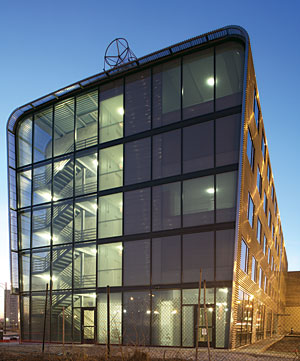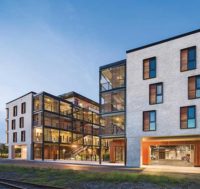For far too long, most publicly funded housing for seniors and the disabled has bordered on being dull, if not downright dismal and “institutional.” But thanks to architects who are lavishing the kind of thoughtful design attention hitherto rarely seen in such developments, and clients who are increasingly willing to take a chance on them, even some publicly funded projects are breaking the mold.
| |
Victor Regnier, FAIA, a University of Southern California professor who specializes in seniors housing design, is currently writing a book on the subject—timely, given the growing demand for these buildings as baby boomers age. Regnier sees a dawning willingness on the part of housing officials to invite innovative design. More important, there’s a new political will to demand it.
One project resulting from this push is Near North Apartments, a single-room occupancy building designed by Helmut Jahn of Murphy/Jahn Architects. Mercy Housing Lakefront commissioned the new $14-million, 96-unit facility to provide permanent residences for low-income or formerly homeless people, some of whom are elderly and disabled. Completed this spring, it stands on the site of Cabrini-Green, an infamous Chicago housing project now mostly demolished. The five-story building is clad in rippled, satin-finish stainless-steel siding. This unpolished facade is tempered by round edges near the rooftop and large, punched windows whose e-coated glazing reflects a faint blue tint. Its elegant, Minimalist design stands out, especially in its infill setting—which is exactly what Cindy Holler, the nonprofit’s president, wanted. “It’s stigma-smashing,” she says. “It’s okay not to be blend in and to be provocative.”

Other new developments are aiming for a more subtle approach, evocative rather than provocative. A 108-unit public housing development for the elderly in Pittsburgh by McCormack Baron Salazar incorporates the history of an African-American neighborhood into its facade design. Architect Dan Rothschild, AIA, of Pittsburgh-based Rothschild Doyno Architects, says he was inspired by the storied Hill District, a popular stop for jazz musicians during the 1920s to 1940s. He incorporated the spirit of jazz into the building’s plan by dividing the front elevation into segments whose widths vary to the relative length of musical notes—a quarter note, half note, or whole note—adding visual rhythm to the streetscape. Construction of the $13 million complex finishes next month.
Regnier observes that more and more projects like this one are employing better design to serve the population they house. “There has been a stronger focus on developing contextually-based designs that gear toward the community and reflect what the city is about,” he explains.
Consideration of context can be achieved not only with exterior details, but also through the architectural program. Regnier cites the Burbank Senior Artists Colony, a complex of 141 senior apartments located near major movie studios in Burbank, California, developed by Meta Housing with some government support. Scheurer Architects designed two recording studios as well as a small theater so that the facility’s residents can flex their creative muscles by producing plays and films.




Post a comment to this article
Report Abusive Comment